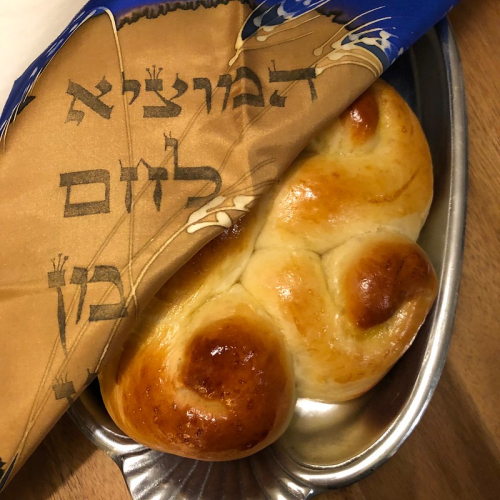Rachel Barenblat's Blog, page 52
December 14, 2019
Approaching the solstice
"Just a few more days," you said,
"until the days start getting longer."
And I thought: I didn't realize
you counted them too, eager
for the satisfaction of knowing
that every day there is more light.
What else did we have in common
that I never took the time to know?

December 13, 2019
Bread and balm
The first thing I do when I wake up on Friday mornings is feed the cat. The second is mix bread flour, yeast, and water. Meanwhile I make my son's breakfast and pack his lunch. By the time I've done those things, it's time to add eggs and oil and sugar and salt, and then more flour, and then I turn it out and run hot water into the bowl while I knead the dough.
I sing "Shalom Aleichem" quietly while I knead, every single time. Usually I sing a melody that's in major. It helps me remember that I'm preparing myself to welcome the angels of Shabbat, not just baking for the sake of tasty treats. And by the time I've sung it through at a pace that suits my hands, the dough is glossy and kneaded, ready to rest in the warm bowl and begin its first rise.
When I take the loaves out of the oven (usually on my lunch break), the house smells rich and sweet -- the scent of Shabbat on her way. At dinnertime when we make motzi and tear into them, the loaves are fragrant and soft and delicious. In the summer, we often make motzi before nightfall. In the winter, sundown is early, and we might not eat until it's well and truly dark out.
Over the last year of baking challah almost every week, the recipe has engraved itself in me. I know it by heart. I made challah with this recipe in Texas last February, on the Shabbat that turned out to be the last one before my mother died. I made challah with this recipe in the Catskills in August, when my Bayit hevre and I gathered for our board retreat / learning week.
Some weeks, like this one, the world feels sharp and painful. The news is difficult to bear. Missing my mom is a sharp ache. Injustice of many kinds is rampant. Fear and grief seem to be life's constant companions. In a week like this, the practice of making challah is a balm to my heart. It says: even with everything that's broken, Shabbes will come with her shelter of peace.
Image: one of this week's loaves of challah, beneath my mother's challah cover. Shabbat shalom to all who celebrate.

December 11, 2019
If you're feeling afraid
If you are feeling anxious and afraid in the wake of the news that the president is going to declare Jews a "nationality," you are not alone. That move comes frighteningly close to declaring that we Jews are therefore not American. And that prospect raises very deep fears, some of them rooted in the horrors of what was done to us in the 20th century in Europe. If you're feeling those fears today, you're not alone.
"All the world is a very narrow bridge," said Reb Nachman. "The important thing is to not make oneself afraid." Let us not make ourselves afraid. Let us resist the impulse to marinate in our fear and give strength to our fear. Let us instead feel the fear, acknowledge it, name it, and then send it on its way. We are Americans. Let us work together with our fellow Americans to ensure not only our own safety but the safety of everyone who is marginalized and mistreated for being who they are.

December 9, 2019
In this place
You're sick, but
still offering opinions
on which cut of trousers
best suits me. You promise
a pair of new boots, stylish
as yours, before you go.
Then you're dead, and
I roam your closet
(Narnia-sized, infinite)
with empty hands. But look:
on a countertop, the boots
you promised, in my size.
I wake laughing.
You're nine months buried
and still giving to me.

December 5, 2019
Vayetzei: the earth in our hands
Jacob left Beersheba, and set out for Haran. He came upon a certain place and stopped there for the night, for the sun had set. Taking one of the stones of that place, he put it under his head and lay down in that place. He had a dream; a stairway was set on the ground and its top reached to the sky, and angels of God were going up and down on it. And Adonai was standing beside him and He said, “I am Adonai, the God of your father Abraham and the God of Isaac: the ground on which you are lying I will assign to you and to your offspring. (Genesis 28:10-13)
These are the opening verses of this week's parsha, Vayetzei. Jacob dreams of a stairway rooted in the earth and reaching the very heavens, with angels going up and down. And when he wakes, he exclaims, "God was in this place, and I -- I did not know!" What an amazing story of spiritual awakening. And this isn't just something that happened to "him" back "then" -- it also happens to us now. We fall spiritually asleep, and then something wakes us into wonder.
This has long been one of my favorite stories in Torah. This year, though, I'm reading it through new eyes -- thanks to our speaker on Wednesday night.
Rabbi Ellen Bernstein is the founder of Shomrei Adamah ("Keepers of the Earth"), the very first Jewish environmental organization, which came into being 30 years ago. She came to CBI to speak about her new haggadah, The Promise of the Land, which offers an earth-centered and environmentally-focused path through the Passover seder.
And one of the first things she said blew my mind. The Hebrew word aretz -- land, earth, ground -- appears 2000 times in the Hebrew scriptures. Often, when we think of "land" in Torah and Jewish tradition, we think of one specific land -- Israel. But what happens if we broaden our sense of aretz to mean all land -- every land -- in other words, the whole earth?
Torah has clear instructions for how we're supposed to treat the land. Torah tells us to care for the land in specific ways, and to behave ethically in specific ways, lest the land spit us out. Seen through the lens of a specific piece of land, those teachings are instructions about how to care for that land, and how to treat each other in that land, lest we become a stateless people again.
But if we read those verses as a teaching about not just that land, but all land -- the whole earth on which we live, the planet that is not only "my land" or "your land" but everyone's land -- and in fact is truly God's land, lent to us only as long as we can care for it responsibly...? Then Torah feels unspeakably prescient. We need to do right by the earth, or the earth will spit us out.
Treat the land with respect. Don't pillage the land. Give back to the land, let the land rest, don't suck all the resources out of the land. Treat the land properly. Treat each other properly and ethically. Don't poison and pollute our community life or our home. Because if we do, the land will spit us out -- the earth will become uninhabitable. Is this sounding familiar?
Granted, Torah doesn't say the planet will warm beyond repair, the ice caps will melt, the seas will rise, the farming systems will fail. Torah doesn't speak in scientific terms. Torah uses the language of ethics and morality, the language of poem and story. Torah just says, "do what's right, or the earth will spit you out." But any newspaper today can give us the horrifying details.
In this week's parsha, Jacob dreams of a ladder rooted in the earth ascending all the way to the heavens, with angels going up and down. And in Jacob's dream, God is right there with him. God says: the ground on which you are lying is yours to care for. Or as Rabbi Bernstein teaches, this entire earth is yours to care for, you and your generations. This planet is in your hands.
Later in his story, Jacob, "the Heel," will gain the new name Yisrael. We are his spiritual descendants, the children of Israel. Like our ancestor, we're spiritually asleep a lot of the time. This week's parsha invites us to wake into wonder. To see the holiness of this place. To recognize that "we've got the whole earth / in our hands" and that it's our job to protect it and give back to it.
In early 2020, we'll be forming the CBI Green Team: a group of congregants, clergy, and staff committed to mitigating the effects of climate change and making climate justice and preservation of the earth core values of our community. The earth is in our hands. Let's wake up to God's presence in every holy place, and together take care of this earth, our irreplaceable home.
This is the d'varling I offered at CBI on Shabbat, offered with gratitude to Rabbi Ellen Bernstein for her teaching and her wisdom. (Cross-posted to my From the Rabbi blog.)

November 26, 2019
Recipe
The year your mother died
I was in college, living
off-campus for the first time.
As Rosh Hashanah approached
I called you for recipes.
I didn't know how to cook, but
I roasted cornish hens
and honeyed carrot coins
and assembled my housemates
around a table covered
with a bedsheet because
I didn't own a white tablecloth.
As this first Thanksgiving
without you draws near,
I'm emailing my sister
and scouring the internet
for a recipe that looks
like the mango mousse
you always made. It's a relic
of the 1950s when your marriage
was new. I don't think
I've ever bought Jell-O
or canned mango before, and
I don't own a fluted ring mold
but when my spoon slices
through creamy sun-gold yellow
it will taste for an instant
like you were in my kitchen,
like you're at my table,
like you're still here.

November 22, 2019
Constancy and change - a d'varling for Chayyei Sarah
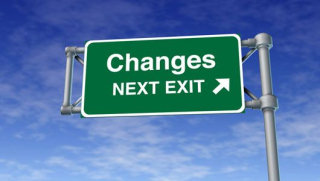 This week's Torah portion, Chayei Sarah, is bookended with funerals. Sarah dies and is buried; then Abraham sends his servant to find a wife for Isaac, and Eliezer brings Rebecca back for Isaac; and then Abraham dies and is buried. This moment in our ancestral story is about generational change. It's about the first patriarch and matriarch being laid to rest, and the next generation picking up the mantle and carrying on our people's story.
This week's Torah portion, Chayei Sarah, is bookended with funerals. Sarah dies and is buried; then Abraham sends his servant to find a wife for Isaac, and Eliezer brings Rebecca back for Isaac; and then Abraham dies and is buried. This moment in our ancestral story is about generational change. It's about the first patriarch and matriarch being laid to rest, and the next generation picking up the mantle and carrying on our people's story.
Torah doesn't say anything about how Sarah felt at the end of her life, but Abraham was "old and contented." I like to think that he was contented because he saw that the next generation was ready to take ownership of the Jewish story. Every generation inherits stories and practices and values from those that came before. And every generation chooses what to lift up and what to let go, out of all of the things they inherit from their forebears.
The Judaism we practice now is not the same as what Abraham and Sarah knew. Honestly it's not the same as what our ancestors knew even a few centuries ago! Our ancestors might be startled to see a female rabbi on the bimah. Or a synagogue where people of all genders sit and pray together. Or a guitar in my hands.
And yet our Judaism is still rooted in the Judaism that our ancestors practiced, the Judaism that our Torah forebears began. We live our Jewish values as our Torah ancestors did: making our "tent" open and welcoming to all, like Abraham. Speaking directly to God, like Rebecca. Dreaming big dreams, like Joseph, even when life takes us into tough places.
It's natural for one generation to give way to the next. And it's natural for Judaism to evolve and grow as we human beings evolve and grow. Every generation has the sacred responsibility, and the joyous opportunity, of keeping our Jewish story alive. Every generation has the sacred responsibility, and the joyous opportunity, of building anew on the foundations laid by those who came before us.
I can't wait to see the Judaism that my son will practice as he grows up -- how it's just like mine, and also how it becomes his own and is different from mine. The Judaism we're building now at CBI is rooted in what came before, and it also needs to be our own, reflecting today's values in balance with the ancient values of gratitude and welcome and seeing each other through generous eyes. This interplay of constancy and change is core to what Judaism is, what Judaism has always been.
I love the fact that this week as we elected new directors and officers to take the helm of CBI, we're reading in Torah about generational change. The page turns and it's time for new figures to take center stage and carry our story forward -- in Torah, and in the lived Torah of our human experience.
May our new directors and officers be blessed with Abraham's spirit of inclusion, with Sarah's capacity for laughter, with Isaac's willingness to tread new ground, with Rebecca's willingness to ask big questions. And may we all be blessed with a Shabbat of wholeness and peace, so that when we make havdalah tomorrow night, we're restored and rejuvenated and ready to continue co-creating this community and writing the next chapter of our people's story, together.
This is the d'varling that I offered at my shul at Kabbalat Shabbat services (cross-posted to my From the Rabbi blog.)

November 11, 2019
A first visit to Cuba 6: Holy spirit
This essay will be posted in nine parts. Once it's all online, I'll also share it as a whole essay for those who prefer to read it in one sitting. This is part six.
6. Holy spirit
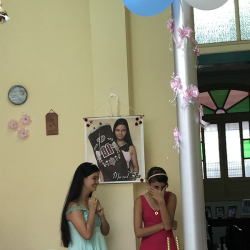
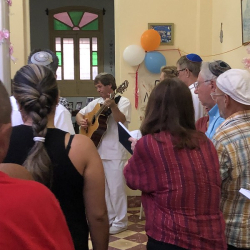
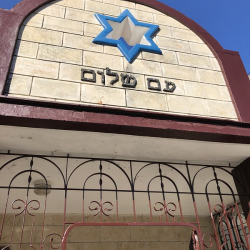
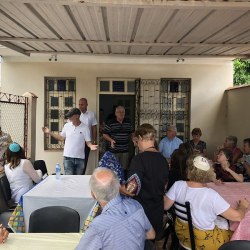
Our next stop is Sancti Spiritus, where motorbikes and bicycles share the roads with horses pulling wagons that serve as group taxis. As in Cienfuegos, our historic hotel is old Spanish-style, built around central courtyards, with old heavy wooden furniture. It feels a million light-years away from the hip mid-century-modern (as though frozen in time) décor of our Havana hotel.
On Friday night our bus takes us on a winding route out of the old part of town and to the home of the Barlia family. Like many houses here, theirs has iron gates and window coverings -- but their wrought-ironwork proudly displays stars of David. The Barlia family hosts, and leads, Kabbalat Shabbat services for Jews of this province twice a month in the courtyard of their home.
This Shabbat their daughter Elisa is becoming bat mitzvah. She lights Shabbat candles in front of a celebratory photograph of herself holding a Torah. She and her sister and R' Sunny lead us in Kabbalat Shabbat, welcoming Shabbat into our midst. Over our heads, a metal grate that looks like fish scales shows the changing colors of the sky and the early-Cheshvan crescent moon.
As in Buenos Aires ten years ago, I am struck by why it matters that Jews pray in Hebrew. Most of us in this group don't share a common language with Cubans. At best we can manage a few phrases. (A couple of us are fluent; most of us... not.) But we can pray with them, welcome Shabbat with them. We can sing ancient words with them, and in those words, our hearts connect.
The bat mitzvah continues on Shabbat morning in Santa Clara, where we convene at Beth Am, a project of the Cuba America Jewish Mission, the nonprofit behind our religious / medical mission to Cuba. Beth Am is the first (and only) new synagogue in Cuba since the Revolution. (It's in a new building, but was a preexisting community; no "new" houses of worship can be built.)
The shul is small, and beautiful, and we fill it: 20 Americans, a few of whom have been coming here for years and know the Barlia family well, and a few dozen locals here to celebrate one of their own. We daven and we sing. The four rabbis on our trip bless the bat mitzvah (with words that I wrote, translated into Spanish!) and we join the Barlia family in chanting from Torah.
After the service we feast on the rooftop of the shul, beside a wall of painted clay tiles that depict different sites across Jerusalem. Before we leave, we gather again in the sanctuary with two guitars and a ukelele and we sing and dance and rejoice. What a mechaieh, a life-giving thing, to get to join the local Jewish community in filling this little synagogue with holy spirit.
Stay tuned for part seven of this essay, coming tomorrow.

November 10, 2019
A first visit to Cuba 5: Tourism and syncretism
This essay will be posted in nine parts. Once it's all online, I'll also share it as a whole essay for those who prefer to read it in one sitting. This is part five.
5. Tourism and syncretism
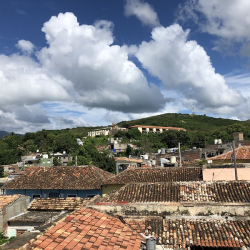
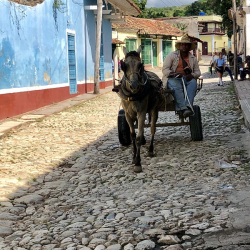
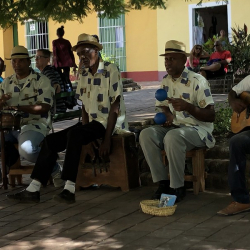
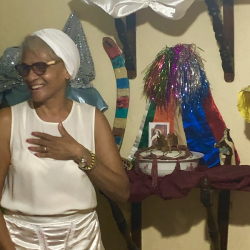
We are also tourists. Our primary purpose is meeting Cuban Jews and delivering medicines, but we also take a day trip to Trinidad. It was abandoned for 85 years, which is why it's one of the world's best-preserved examples of Spanish colonial architecture. On the way there, we pass a Russian nuclear plant that never worked. Some things in Cuba feel like a Kafka story.
In Trinidad the streets are "paved" with local stones and with cobbles brought as ballast from Europe. There are men in guayaberas with instruments, playing Guantanamera beneath shady trees. There are artisans selling lace and embroidery and wooden boxes of dominos, their prices lowering as we walk past. There aren't many other tourists -- at least not that I can see.
From the luxurious rooftop paladar where we lunch I see children playing amidst red clay tiles and chicken coops. They wave at us. Dare we hope that our tourist dollars are helping them? When we get back to our stunning old Cienfuegos hotel I go for a swim in the pool in the courtyard. How can I square this gracious opulence with the deprivations that locals take for granted?
This place is extraordinary. Beautiful. Musical. Literate. And the Cuban people I meet everywhere we go clearly feel pride in who and where they are. And it's also clear that they need the help, medical and fiscal, that we're here to bring. I'm thinking about scarcity and poverty... with awareness that those things exist in my country too. My usual orbit just allows me not to see them.
On our first full day in Cuba we visited an apartment in a working-class neighborhood of Havana where two women taught us about Santeria (also known as Regla de Ocha). Santeria is a religious tradition that intertwines Yoruba orishas (which the translator renders as "guardian angels") with Catholicism. Seventy percent of Cubans have some interaction with Santeria.
We learned about the altars, the figures depicted there, appropriate offerings for each and the relationships between them. We learned how the initiation process works. I was fascinated by how it dovetails with going to mass. Apparently the local Catholic priests recognize Santeria initiates, and don't seem to mind the religious syncretism. (Or at least, they allow it to continue.)
Some of what the women in that apartment shared with us is utterly unlike Judaism. And some of it evokes ideas from my tradition. Maybe inevitably, I'm always looking for resonance. I wonder what it was like for these women to host this group of American Jews. I worried that they might feel exposed, but they seemed delighted to be able to share their tradition with us.
After that visit, whenever I see someone wearing all white I wonder whether that person is a Santeria initiate. Many of us in this Jewish tour group wear all-white on Shabbat, a custom that comes from the mystics of Tzfat who created the Kabbalat Shabbat service as we know it. Maybe the locals, seeing us in our Shabbat whites, imagine that we are Santeria initiates too.
Stay tuned for part six of this essay, coming tomorrow.

November 8, 2019
A first visit to Cuba 2: The things we carry
This essay will be posted in nine parts. Once it's all online, I'll also share it as a whole essay for those who prefer to read it in one sitting. This is part two.
2. The things we carry
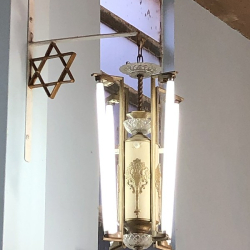
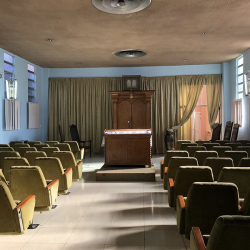
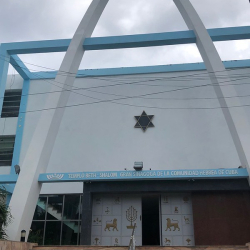
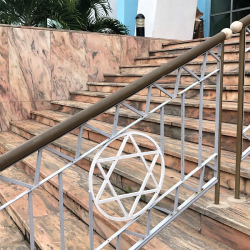
Everywhere we go on the island we bring medical supplies. Our first two stops are the Centro Sefaradi and the Patronato in Havana. Their pharmacy shelves were bare, emptied since last time R' Sunny was here six months ago. They disburse medical supplies to anyone who needs, Jewish or not. There are other pharmacies (we visit one later) but their shelves are spare too.
So much that we take for granted is not available to Cubans. We've brought aspirin, vitamins, diapers, soap, prescription drugs. "Rite Aid or Walmart is like science fiction to us," says one Cuban who has traveled abroad. I lose track of how many times and in how many ways my heart breaks. And I also lose track of how many times and in how many ways my heart soars.
Even just in Havana. The chapel at the Centro Sefaradi has light fixtures from Shevet Achim in Old Havana, the first Sefaradi congregation in Cuba, founded by immigrants from Turkey and Syria. Those fixtures still shine. I mean this literally and metaphorically! At the Patronato, I'm moved by the cheery preschool classroom funded by the Cuba America Jewish Mission.
The sanctuary at the Patronato looks like every mid-20th-century synagogue I've ever seen. Like the classic cars that serve as taxis all over Havana, it's been repaired and patched and kept running ever since it was new. At home a space like that would feel staid, but it feels different here, even defiant here. It's still here; it hasn't gone away; Judaism hasn't gone away.
And yet many Jews have departed. For the United States, for Israel, for Spain, for Mexico. There are fewer than a thousand Jews left on this island. The further inland we go, the smaller the communities we meet -- but the heart and spirit we experience praying with them, eating with them, singing with them, just being with them, is enormous. Outsized. "My cup overflows."
Stay tuned for part three of this essay, coming tomorrow.

Rachel Barenblat's Blog
- Rachel Barenblat's profile
- 6 followers


